Author: Tiffany Luehrs
Location: Hangzhou, China
The dreary weather added to the wonder of the city of Chongqing. It gave the city an eerie feel as we looked out at the panoramic view from the side of a hill. After a delicious hot pot of dinner, a spicy delicacy of the Si Chuan province , we headed to the docks to board the Victoria cruise ship.
 Looking around, I noticed that the city had transformed as the moon rose. At night Chongqing was beautifully lit up, and I was enamored by the reflection of the colorful city lights shimmering in the gentle waves of the Yangtze river. As I stepped on the cruise ship, I was excited and curious to see what the next three days on the Yangtze would reveal.
Looking around, I noticed that the city had transformed as the moon rose. At night Chongqing was beautifully lit up, and I was enamored by the reflection of the colorful city lights shimmering in the gentle waves of the Yangtze river. As I stepped on the cruise ship, I was excited and curious to see what the next three days on the Yangtze would reveal.
During the cruise, we were able to attend various lectures, one of which was on Chinese medicine. I knew the basics of Chinese medicine: herbal remedies, cupping, scraping, and acupuncture. But that was about it. The lecture was intriguing, and I learned how the methods of acupuncture, acupressure massage, cupping, and scraping relate to the theory of Yin and Yang, a Taoist concept of interdependence between passive and active forces. When your Yin and Yang is balanced, you are healthy, but when your Yin and Yang are unbalanced, there is a blockage of your 气 (qi) or the energy flow that takes place throughout the channels of your body, causing illness or discomfort.
During our journey, we also had the opportunity to go on a few 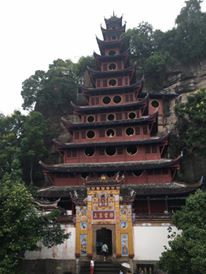 excursions by foot, one of which was to see and climb the Shibao Pagoda. To get to the pagoda, we had to cross a slippery, shaky bridge with a terrifying drop beneath our feet. My usually dormant fear of heights came out of hibernation at full force as I walked along the bridge, clinging to the railing and trying not to look down. The perilous crossing was worth it. The 12-story, red pagoda was constructed out of wood without any nails. Since the 18th century when the temple was built, there have been renovations to the structure to preserve the temple and make it safe to enter and climb.
excursions by foot, one of which was to see and climb the Shibao Pagoda. To get to the pagoda, we had to cross a slippery, shaky bridge with a terrifying drop beneath our feet. My usually dormant fear of heights came out of hibernation at full force as I walked along the bridge, clinging to the railing and trying not to look down. The perilous crossing was worth it. The 12-story, red pagoda was constructed out of wood without any nails. Since the 18th century when the temple was built, there have been renovations to the structure to preserve the temple and make it safe to enter and climb.
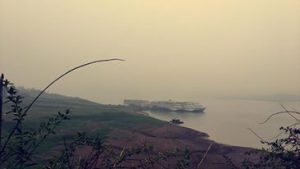 The saying goes that the higher one climbs in the temple, the more likely your dreams will come true. You know I climbed all the way up. I even ventured up the feeble, volatile ladder that led to a claustrophobic, square scenic outlook room at the very top of the temple, which only had enough room for around four people at a time. At the top of the pagoda, I was able to look out at our cruise ship along side two other ships amidst the hazy sky and grey waters.
The saying goes that the higher one climbs in the temple, the more likely your dreams will come true. You know I climbed all the way up. I even ventured up the feeble, volatile ladder that led to a claustrophobic, square scenic outlook room at the very top of the temple, which only had enough room for around four people at a time. At the top of the pagoda, I was able to look out at our cruise ship along side two other ships amidst the hazy sky and grey waters.
While on the cruise, we witnessed three gorges: Qu Tang, Wu, and Xi Ling. The three gorges were magnificent and unlike anything I had ever seen. It was at Xi Ling Gorge that our journey ended, and we were greeted by the Three Gorges Dam, the world’s largest hydropower project. The beautiful mountainous landscape is still present but interrupted by the dam. As Watts, the author of When a Billion Chinese Jump stated, the dam was a “gray scar on an otherwise stunning landscape.”
While the Chinese have been building dams ever since the first was built in around 600 BC at Anfeng Tang in eastern China, the Three Gorges Dam is the first dam built on such a large scale. It generates incredible amounts of electricity, improves navigation along the Yangtze river, and allows for flood control, but at enormous costs.
This gray scar has caused the displacement of 1.4 million people, 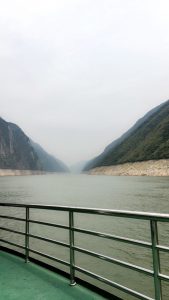 water pollution, loss of biodiversity, the introduction of new diseases, and an increased risk of earthquakes and landslides. It was amazing and surreal to finally see the dam in person after researching the hydropower project in my Environmental Biology of China class and having watched Up the Yangtze. It was definitely an eye opening and fascinating way to end our 10-day travel excursion during G20. Now it’s time to head back to Hangzhou and truly get started on the “study” part of study abroad. 😉
water pollution, loss of biodiversity, the introduction of new diseases, and an increased risk of earthquakes and landslides. It was amazing and surreal to finally see the dam in person after researching the hydropower project in my Environmental Biology of China class and having watched Up the Yangtze. It was definitely an eye opening and fascinating way to end our 10-day travel excursion during G20. Now it’s time to head back to Hangzhou and truly get started on the “study” part of study abroad. 😉
-Tiffany
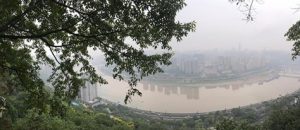
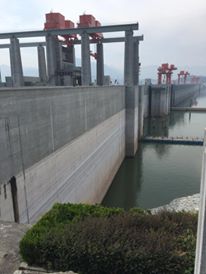
Leave a Reply